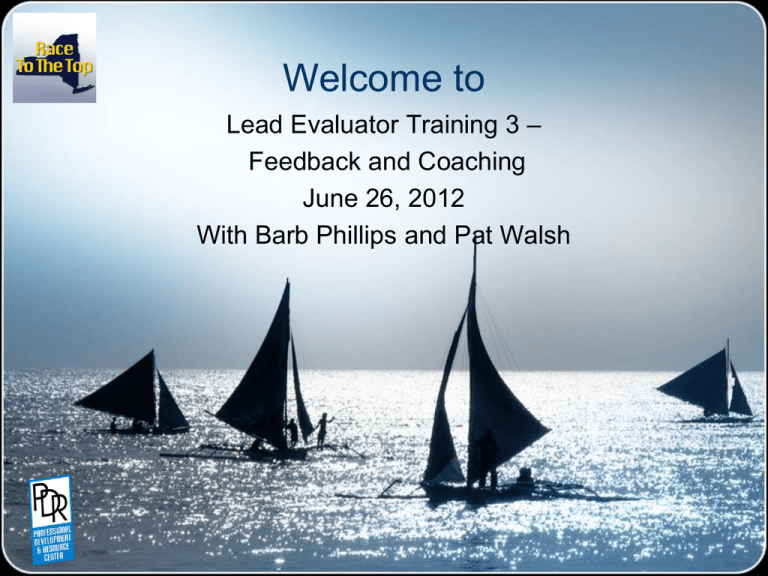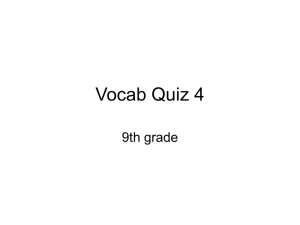LET 3 Presentation
advertisement

Welcome to Lead Evaluator Training 3 – Feedback and Coaching June 26, 2012 With Barb Phillips and Pat Walsh In Focus with Dr. Jon Saphier - “Say Something” • What was something that stood out to you as you listened to Jon? • If you quoted him, what quote did you choose to bring and why? http://www.youtube.com/watch?v=fQz69uz A03Y • What are you thinking about as you reflect on the clip? How does it relate to the thinking of your district with respect to your APPR conversations and your district areas of focus in your APPR plans? Leaders will… • Describe current practices for responding to teacher performance • Define the characteristics of praise, criticism and feedback • Explain how feedback is related to Evidence Based Observation and to the language of the rubric • Describe how local decisions about scoring observations impact feedback for improvement • Use four criteria for evidence to label feedback • Describe recommended components of action plans to improve instruction Thinking back to our earlier Lead Evaluator work…. • • • • • • • • • The Third Grade ELL teacher… The Biology lesson… The Eighth Grade Social Studies teacher The Sixth Grade Math teacher The Ninth Grade Math lesson The Global Studies lesson The elementary writing lesson The Socratic Seminar The Sixth Grade Science lesson So many of you wanted to “jump in” and “coach”, talk with the teacher, respond to their teaching! This gets to the heart of today! How do you respond to teacher performance? What is your current practice? • The content of written documents? written or unwritten “rules”? What is your current practice? • What is the nature of post-observation? The evaluator’s role? The teacher’s role? We respond in writing or verbally in three ways to practice. Global Studies Lesson – Exit Activity for Lead Evaluator Training 2 Feedback, criticism or praise? Which one is it? Great job with student engagement! I know you have been working on that and it shows. Praise As a building we have been stressing engagement of students. Keeping them in pairs will engage them more. Criticism T- “We are going to do an activity called triples read. In triples, one person will read out loud one column of the chart, the other two students just listen, and then the two students who listened will verbally summarize what they think they just heard” Feedback Praise, Criticism and Feedback What are the characteristics of each? Praise is….. • Expressing approval or commending performance Why do we praise? Build confidence and self-esteem Recognition for a job well done Positive feeling – tone Motivation Criticism is….. • Act of judgment – often takes on a negative connotation Why do we criticize? • Frustration • Feeling-tone • We think we are changing practice… • We want to give “constructive” criticism Feedback is…. • Descriptive • Specific • Non-judgmental Sounds like Evidence Based Observation! Adventures in weight training Great job! Look how far you have come! You haven’t lifted that much before. If you keep doing it that way. You will hurt yourself. When you place your hands on the bars and use this grip, you will strengthen your trap muscles and not injure your neck. Global Studies Lesson – Exit Activity for Lead Evaluator Training 2 Feedback, criticism or praise? Which one is it? Great job with student engagement! I know you have been working on that and it shows. Praise As a building we have been stressing engagement of students. Keeping them in pairs will engage them more. Criticism T- “We are going to do an activity called triples read. In triples, one person will read out loud one column of the chart, the other two students just listen, and then the two students who listened will verbally summarize what they think they just heard” Feedback I called it engaged learning because the triples read put students in roles where all students were engaged, relevant to your outcome. “Feedback is not about praise or blame, approval or disappointment. Feedback is valueneutral. It describes what you did and did not do. Praise is necessary but praise only keeps you in the game. It doesn’t get you better.” - Grant Wiggins Feedback is most effective when… • Recipient makes meaning from it • It is provided in time to make a difference • The culture influences perceptions about improvement • There is just enough- not too much! Use the positive power of your position to influence… Describe strengths and missed opportunities By Giving objective, specific feedback Based on Multiple Areas of Performance For the purpose of Changing and Improving Current Practice to More Skillful Practice What is the relationship between … Evidence Based Observation practices we have been learning and the rubrics your district’s have chosen? Labeling teacher practice and eventually scoring it depends on the agreed upon attributes of effective teaching practice and the language and construct of the rubric. Quality evidence is….OARS • Objective and specific – free of bias/opinion, quantified • Aligned to indicators/elements of the rubric – ie: 3.1c –NYSUT – Engages Students • Representative – Evidence in all areas of teacher performance • Sufficient - Enough evidence to make a final judgment Teaching and Learning Solutions Trends in evidence from the Lead Evaluator 2 evidence collection assignment: • Increased objectivity, however, still some tendency to summarize and to judge e.g., “teacher gave little wait time” “teacher called on numerous students” “teacher asked effective questions” “transition was smooth” “the objective was posted on the board” Trends in evidence continued….. • More balance between teacher words/actions and student words and actions…keep this up! Especially quotations….Having this information will help you give more concrete/meaningful feedback to the teacher. T -“As a refresher, look at the geography of Greece. How did that contribute to the rise of city states?” S – “mountains in Greece that created isolation” T – “Anything else that created the city states?” S2 – “surrounded by water” T – “what’s going to be hindered by the isolation of city states?” S3 – “isolation” S4 – “trade” Trends in evidence continued… • 1. 2. 3. 4. You were labeling your evidence correctly when you had to sort it and label it as: Check for understanding (all students, relevant observable behavior so the teacher can see they “got it”) Engaged learners ( all students, consistently, relevant to the outcome) Effective questions (range of questions, all invited to think, time to think) 4. Teach to an Outcome (all (questions, activities, feedback) relevant to outcome, time used efficiently) Quality evidence is….OARS • Objective and specific – free of bias/opinion, quantified • Aligned to indicators/elements of the rubric – ie: 3.1c –NYSUT – Engages Students • Representative – Evidence in all areas of teacher performance – We picked 4 areas – 4 5 pieces of evidence for each area • Sufficient - Enough evidence to make a final Teaching and Learning Solutions judgment – Ready to observe, “script”, label and give feedback? Student engagement - What is the language in your rubric with respect to student engagement? Elida Gallegos – ELA Lesson • Observe and take down evidence ELA Lesson Outcomes • Students will use listening, speaking, reading and writing to improve comprehension • Students will understand how to use key details to summarize • Students will work collaboratively to summarize a chapter from the novel, Bridge to Terabithia • Students will think creatively Next steps… • “clean up” your evidence • Sort through evidence – What evidence will you use to give Elida feedback on student engagement? • Create an additional word document you can sort this into (copy and paste) or use the paper provided if you choose Giving verbal feedback • What do you notice? Giving Feedback - Practice • Principal • Teacher • Observer A B C B C A C A B Gives verbal feedback • The observer will give “feedback” - What did you notice specifically about the “principal” as they conveyed feedback. Let’s debrief Gallegos Evidence Collection • With your partner or small group, review the written evidence exemplar for Ms. Gallegos and compare it with your own evidence and labeling Recommended practices for the teacher improvement process and planning Fostering teacher ownership and providing focus and support “The principal owns the responsibility for defining the areas where improvement is needed. The teacher must share ownership for the development and implementation of the plan.” Michelle Howser Recommended practices for the teacher improvement process and planning Establish Assistance team • Shares in the setting of goals and developing the plan ( teacher, primary supervisor, curriculum specialist, teacher mentor) • Clearly communicates the school’s (districts’) commitment to improvement and growth Select Focus area(s) •Objectively communicate area(s) of teacher’s practice that are the focus of he plan. Mrs. Friendly does not frame the learning (both the objective and the sequence of activities) for students and does not regularly communicate the reasons for activities. Recommended practices for the teacher improvement process and planning Develop Performance Goals • Specific and measurable Mrs. Friendly will communicate to students the lesson and unit objectives and the sequence of lesson and unit events. Select strategies, Activities/w/timetable • Targeted directly to goals and specific enough to be implemented effectively •They need to be measurable •They assign the teacher responsibility for doing the work. •They specify a timetable Recommended practices for the teacher improvement process and planning Determine need for support structures Choose data collection sources What will be collected and who will collect it? Decide on evidence to document progress Teacher Improvement Plan • A way of laying out the process guided by the recommendations… One Principal’s thinking • What do the documents and process look like for you? – District conversation • Pair-up with colleagues from another district to share thinking Next steps…. Upcoming Events….. • SLO Assessment Development Work • Lead Evaluator Training – 1 – 3 • Principal evaluation work • Rubric specific work • Summer Network Team Institutes July 9 – 13 and August 13 - 17 “I would like to suggest that the ‘first thing’, the most important feature of our job description for each of us as educators, is to discover and provide the conditions under which people’s learning curves go off the chart. Sometimes its other people’s learning curves: those of students, teachers, parents, administrators. But at all times it is our own learning curve. ’’ Roland Barth Feedback to us on blue sheets. Thank you so much. See you soon.








